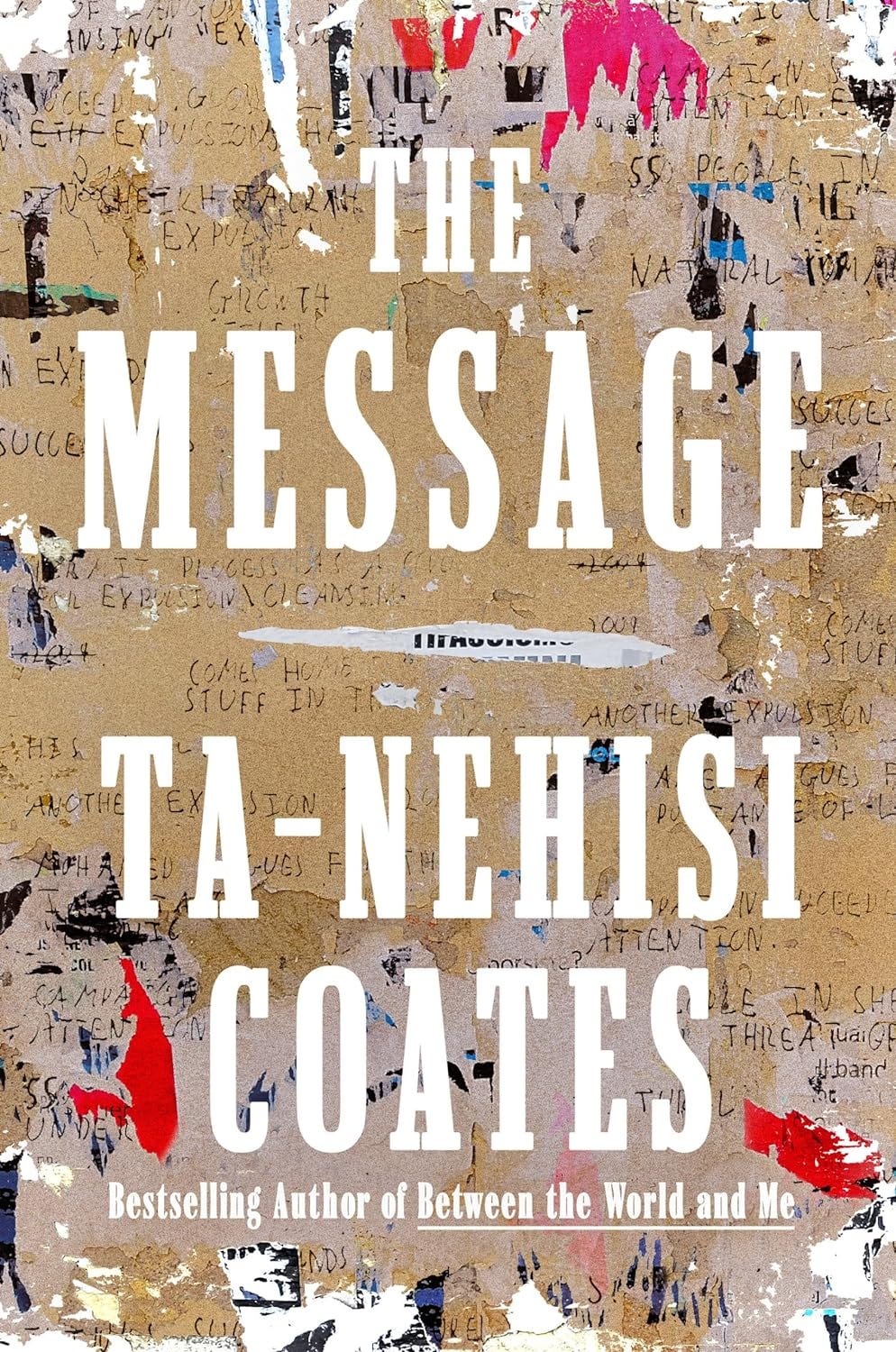
I picked up Ta-Nehisi Coates’s new book The Message on Tuesday and finished it early this morning. It’s a fast read, but it packs a big punch, one that is already being critiqued on mainstream news and beyond. The most controversial section and also the longest chapter in the book focuses on his trip to Israel/Palestine and his claim that Israel functions as an apartheid state.
The book as a whole, however, is a letter to his students at Howard University on the power of writing and the responsibilities of the writer. What I took away from the book is a powerful and deep meditation on the importance of narrative and the way stories shape how we see ourselves in connection with the broader world.
References to Civil War memory and debates surrounding the teaching of race and the history of slavery are sprinkled throughout the book as Coates travels to Africa, Israel/Palestine, and especially to South Carolina, where he accompanied a teacher to a community meeting that was considering banning one of his earlier books.
The Message reinforced for me the political import of many, if not all, of our narratives about the past. The stories we choose to tell shape and give justification to the very nation-state that we call home. Our narratives wrap us (assuming you are fortunate enough to be included in ‘us’) with a sense of security and clear boundaries, but almost always in contrast with those that are deemed to be outsiders. In the United States that has traditionally included African Americans, Native Americans, but most recently we hear it in a presidential candidate’s fear mongering and demonization of immigrant groups.
These narratives have everything in common: intentionality, exclusion, justification, and othering. It’s intentionality that turns a seemingly passive monument or statue into a message and justification for exclusion. As Coates observes:
You don’t raise the kind of looming statues I saw at the State House just for the hell of it. Politics is that art of the possible, but art creates the possible of politics. A policy of welfare reform exists downstream from the myth of the welfare queen. Novels, memoirs, paintings, sculptures, statues, monuments, films, miniseries, advertisements, and journalism all order our reality. Jim Crow segregation—with its signage and cap-doffing rituals—was both policy and a kind of public theater. The arts tell us what is possible and what is not, because, among other things, they tell us who is human and who is not. (pp. 106-07)
In Jerusalem, Coates visited the archaeological site of the City of David only to learn that the evidence for such a claim is flimsy at best. The site interpretation offered one among a number of origin myths that could serve as a justification for the occupation and for the state of Israel itself.
The Israeli writer and chronicler Amos Elon once described archaeology in Israel as ‘almost a national sport,’ which had captivated a nation forever looking for ‘the reassurance of roots.’ Elon noted that Israeli national symbols were almost wholly drawn from antiquities. ‘For the disquieted Israeli,’ Elon wrote, ‘the moral comforts of archaeology are considerable.’ Like that of the British before them, Zionist archaeology sought to affirm the Bible as history to affirm its state project. What that project needed was an unbroken narrative, stretching back in time immemoral, of Jewish nationhood. With such a narrative in hand, Israel wold then have what Ben-Gurion called ‘the sacrosanct title-deed to Palestine.’ (p. 190-91)
A few pages later, Coates shares the inscription on a plaque in one of the exhibit rooms at the City of David site placed by a former United State ambassador expressing solidarity with Israel and more:
‘The City of David brings Biblical Jerusalem to life at the very place where the kings and the prophets of the Bible walked. The spiritual bedrock of our values as a nation comes from Jerusalem. It is upon these ideals that the American republic was founded, and the unbreakable bond between the United States and Israel was formed.’
My point in sharing these passages is not to express agreement with Coates’s entire argument in this book, but to highlight a much larger insight that I’ve attempted to better understand over the years.
We are as much a product of our stories as they are of us or to paraphrase the philosopher and cognitive scientiest Daniel Dennett, ‘our stories spin us as much as we spin them.’
What I take away from The Message is the need for a healthy skepticism regarding the stories that nations tell about itself and the rest of the world to justify its existence. This observation extends to the narratives we embrace from political, religious, and social institutions as well. Finally, it extends to the narratives that each of us has embraced for various reasons abour ourselves, our families, and as members of a nation.
In all cases, we are forced to confront the same questions: Who or what do these stories serve or empower? What kind of community are they intended to create? Who gets remembered and celebrated? Who gets vilified or lost to the past?















I'm very excited to read this book. I've never encountered a writer who says exactly what they mean better than Coates does. And you post make a fine point; whenever we examine the stories told about our past, we need to recognize that all the story-tellers have an axe to grind and consider in what context and for what purpose and audience they were devised.
I like where you're going with this. My wife and I returned last night from a month on an alumni tour with nearly two dozen fellow alums considering the archaeological ruins of Türkiye led by a Turk with some Greek ancestry and a wealth of knowledge accumulated as a tour guide for more than thirty years. We visited numerous mosques, museums, archaeological digs, battlefields, art galleries, restored cities, countless monuments and extended bus rides filled with detailed discussion of current events, historical analysis of national development, Eastern Orthodoxy, population migrations, genocides, colonial exploitation, boat tours of the Hellespont and the Bosphorus and the roles those geographical features have played as the gateway between the East and the West. It's a lot of material to digest in just a few weeks. Several of my fellow alums had been, like me, English majors, back in the days when that degree was still a synonym for unemployable. I remember when that and fifty cents could get you a cup of coffee. Substitute teaching then required a teaching credential from an authorized school of education. Fifteen hours of period lit would fulfill a requirement. Sixty or more was disqualifying. One of those fellow alums had taken courses from two of the English professors from whom I had taken multiple courses. One of those courses had only three texts, the collected works of Samuel Johnson, James Boswell's biography of Samuel Johnson and Edward Gibbon's Decline and Fall of the Roman Empire, Dero Saunders abridged edition. Our tour guide greatly appreciated having at least one or two people aboard who understood what he meant when he called something Byzantine. I spent my third year of college on the rooftop of the Moody Towers men's dorm in Houston reading both volumes of Spengler's Decline of the West (Das Untergang des Abendlandes) instead of going to class, and for that I was expelled from the Honor's Program. The advisor was a history professor. Toynbee was part of the curriculum. Spengler was not. Both Heidegger's 'Being and Time' and Sartre's 'Being and Nothingness' were banned books in the philosophy department. At least the English Department would let you read 'Les Nausea. The tour ended with three nights in Cappodocia spent in a hotel that consisted entirely of cliffside cave dwellings. It was perfect for surveying the otherworldly landscape from a hot air balloon.